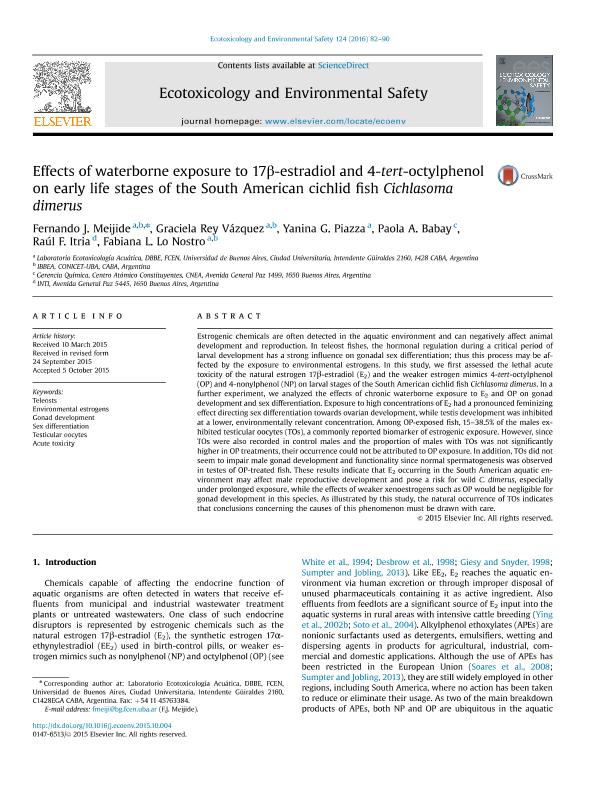Mostrar el registro sencillo del ítem
dc.contributor.author
Meijide, Fernando Javier

dc.contributor.author
Rey Vázquez, Graciela

dc.contributor.author
Piazza, Yanina Grisel

dc.contributor.author
Babay, Paola Alejandra

dc.contributor.author
Itria, Raúl Fabio

dc.contributor.author
Lo Nostro, Fabiana Laura

dc.date.available
2017-07-14T15:45:26Z
dc.date.issued
2015-10
dc.identifier.citation
Meijide, Fernando Javier; Rey Vázquez, Graciela; Piazza, Yanina Grisel; Babay, Paola Alejandra; Itria, Raúl Fabio; et al.; Effects of waterborne exposure to 17β-estradiol and 4-tert-octylphenol on early life stages of the South American cichlid fish Cichlasoma dimerus; Elsevier Inc; Ecotoxicology and Environmental Safety; 124; 10-2015; 82-90
dc.identifier.issn
0147-6513
dc.identifier.uri
http://hdl.handle.net/11336/20528
dc.description.abstract
Estrogenic chemicals are often detected in the aquatic environment and can negatively affect animal development and reproduction. In teleost fishes, the hormonal regulation during a critical period of larval development has a strong influence on gonadal sex differentiation; thus this process may be affected by the exposure to environmental estrogens. In this study, we first assessed the lethal acute toxicity of the natural estrogen 17β-estradiol (E2) and the weaker estrogen mimics 4-tert-octylphenol (OP) and 4-nonylphenol (NP) on larval stages of the South American cichlid fish Cichlasoma dimerus. In a further experiment, we analyzed the effects of chronic waterborne exposure to E2 and OP on gonad development and sex differentiation. Exposure to high concentrations of E2 had a pronounced feminizing effect directing sex differentiation towards ovarian development, while testis development was inhibited at a lower, environmentally relevant concentration. Among OP-exposed fish, 15–38.5% of the males exhibited testicular oocytes (TOs), a commonly reported biomarker of estrogenic exposure. However, since TOs were also recorded in control males and the proportion of males with TOs was not significantly higher in OP treatments, their occurrence could not be attributed to OP exposure. In addition, TOs did not seem to impair male gonad development and functionality since normal spermatogenesis was observed in testes of OP-treated fish. These results indicate that E2 occurring in the South American aquatic environment may affect male reproductive development and pose a risk for wild C. dimerus, especially under prolonged exposure, while the effects of weaker xenoestrogens such as OP would be negligible for gonad development in this species. As illustrated by this study, the natural occurrence of TOs indicates that conclusions concerning the causes of this phenomenon must be drawn with care.
dc.format
application/pdf
dc.language.iso
eng
dc.publisher
Elsevier Inc

dc.rights
info:eu-repo/semantics/openAccess
dc.rights.uri
https://creativecommons.org/licenses/by-nc-nd/2.5/ar/
dc.subject
Teleosts
dc.subject
Environmental Estrogens
dc.subject
Gonad Development
dc.subject
Sex Differentiation
dc.subject
Testicular Oocytes
dc.subject
Acute Toxicity
dc.subject.classification
Otros Tópicos Biológicos

dc.subject.classification
Ciencias Biológicas

dc.subject.classification
CIENCIAS NATURALES Y EXACTAS

dc.title
Effects of waterborne exposure to 17β-estradiol and 4-tert-octylphenol on early life stages of the South American cichlid fish Cichlasoma dimerus
dc.type
info:eu-repo/semantics/article
dc.type
info:ar-repo/semantics/artículo
dc.type
info:eu-repo/semantics/publishedVersion
dc.date.updated
2017-07-04T15:33:26Z
dc.journal.volume
124
dc.journal.pagination
82-90
dc.journal.pais
Estados Unidos

dc.description.fil
Fil: Meijide, Fernando Javier. Consejo Nacional de Investigaciones Científicas y Técnicas. Oficina de Coordinación Administrativa Ciudad Universitaria. Instituto de Biodiversidad y Biología Experimental y Aplicada. Universidad de Buenos Aires. Facultad de Ciencias Exactas y Naturales. Instituto de Biodiversidad y Biología Experimental y Aplicada; Argentina
dc.description.fil
Fil: Rey Vázquez, Graciela. Consejo Nacional de Investigaciones Científicas y Técnicas. Oficina de Coordinación Administrativa Ciudad Universitaria. Instituto de Biodiversidad y Biología Experimental y Aplicada. Universidad de Buenos Aires. Facultad de Ciencias Exactas y Naturales. Instituto de Biodiversidad y Biología Experimental y Aplicada; Argentina
dc.description.fil
Fil: Piazza, Yanina Grisel. Universidad de Buenos Aires. Facultad de Ciencias Exactas y Naturales. Departamento de Biodiversidad y Biología Experimental. Laboratorio de Ecotoxicología Acuatica; Argentina. Consejo Nacional de Investigaciones Científicas y Técnicas; Argentina
dc.description.fil
Fil: Babay, Paola Alejandra. Comision Nacional de Energia Atomica. Centro Atomico Constituyentes; Argentina
dc.description.fil
Fil: Itria, Raúl Fabio. Instituto Nacional de Tecnología Industrial; Argentina
dc.description.fil
Fil: Lo Nostro, Fabiana Laura. Consejo Nacional de Investigaciones Científicas y Técnicas. Oficina de Coordinación Administrativa Ciudad Universitaria. Instituto de Biodiversidad y Biología Experimental y Aplicada. Universidad de Buenos Aires. Facultad de Ciencias Exactas y Naturales. Instituto de Biodiversidad y Biología Experimental y Aplicada; Argentina
dc.journal.title
Ecotoxicology and Environmental Safety

dc.relation.alternativeid
info:eu-repo/semantics/altIdentifier/doi/http://dx.doi.org/10.1016/j.ecoenv.2015.10.004
dc.relation.alternativeid
info:eu-repo/semantics/altIdentifier/url/http://www.sciencedirect.com/science/article/pii/S0147651315301214
Archivos asociados
